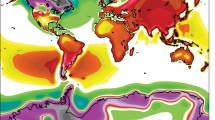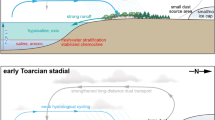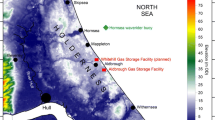Abstract
The article deals with deposits exposed in sections along the rivers of the Caspian lowland and on the eastern slope of the Ergenei. The conclusion is made about the lagoonal origin of chocolate clays lying on high-capacity subaerial and alluvial–deltaic deposits. The impact of the Caspian Sea level rise on coastal processes is examined. Taking into account the regularities in the behavior of the coastal zone during sea level rise, subaerial deposits with such thickness in the outcrops could not have been preserved during the early Khvalynian transgression from –100 m. Another curve of Caspian Sea level fluctuations is proposed, where there is no deep Atelian regression between the Khazarian and Khvalynian transgressions. It is concluded that the Khazarian transgression was one of the largest in the history of the Caspian Sea. Its level was slightly less than that of the Khvalynian transgression. The rise of the level of the latter began not from –100 m, but from about 5–15 m; i.e., this transgression was in fact an oscillation of the Caspian Sea against its gradual regression after the Khazarian transgression. Sea level oscillations contributed to the formation of lagoonal-transgressive terraces, in which chocolate clays accumulated.







Similar content being viewed by others
Notes
The malacofauna was determined by prof. T.A. Yanina
REFERENCES
E. N. Badyukova, A. N. Varushchenko, and G. D. Solov’eva, “Influence of sea level fluctuations on the development of the coastal zone,” Vestn. Mosk. Univ., Ser. 5: Geogr., No. 6, 83–89 (1996).
E. N. Badyukova, “The genesis of Khvalynian chocolate clays in the Northern Caspian region,” Byull. Mosk. O‑va. Ispyt. Prir., Otd. Geol. 75 (5), 25–31 (2000).
E. N. Badyukova and G. D. Solov’eva, “Lagoon-transgressive terraces,” Geomorfologiya, No. 3, 36–43 (2003).
E. N. Badyukova, “Age of Khvalynian transgressions in the Caspian Sea region,” Oceanology (Engl. Transl.) 47, 400–405 (2007).
E. N. Badyukova, “The history of fluctuations in the level of the Caspian in the Pleistocene: Was there a great Khvalynian transgression?” Byull. Kom. Izuch. Chetvertichn. Perioda, Ross. Akad. Nauk, No. 74, 111–120 (2015).
Yu. P. Bezrodnykh, S. V. Deliya, B. F. Romanyuk, et al., “New data on the upper quaternary stratigraphy of the North Caspian Sea,” Dokl. Earth Sci. 462, 479–483 (2015).
Yu. P. Bezrodnykh, V. M. Sorokin, and T. A. Yanina, “The Athelian regression of the Caspian Sea,” Vestn. Mosk. Univ., Ser. 5: Geogr., No. 2, 77–85 (2015).
M. P. Britsyna, “Distribution of Khvalynian chocolate clays and paleogeography of the Northern Caspian region,” Tr. Inst. Geogr., Akad. Nauk SSSR, No. 62, 5–27 (1954).
S. I. Varushchenko, A. N. Varushchenko, and R. K. Klige, Dynamics of Regime of the Caspian Sea and Closed Reservoirs in Paleoperiod (Nauka, Moscow, 1987) [in Russian].
M. M. Zhukov, “The stratigraphy of the Caspian sediments of the lower Volga region,” Tr. Kom. Izuch. Chetvertichn. Perioda, No. 2, 227–272 (1935).
M. M. Zhukov, Problems of Western Kazakhstan (Academy of Sciences of USSR, Moscow, 1945), Vol. 2.
A. S. Zastrozhnov, S. V. Popov, and D. A. Zastrozhnov, “Problems of the Lower Volga sections of Neopleistocene,” in Proceedings of the VIII All-Russian Conference on the Quaternary Period Research “Fundamental Problems of Quaternary: Study Results and Prospective Studies” (Rostov-on-Don, 2013), pp. 207–209.
V. P. Zenkovich, Fundamental Theory on Development of the Sea Coasts (Academy of Sciences of USSR, Moscow, 1962) [in Russian].
P. N. Kuprin and A. G. Roslyakov, “Geological structure of the Mangyshlak sedimentary body,” Geotektonika, No. 2, 28–40 (1991).
Yu. A. Lavrushin, E. A. Spiridonova, A. Tudrin, et al., “The Caspian region: hydrological events of Later Quaternary,” Byull. Kom. Izuch. Chetvertichn. Perioda, Ross. Akad. Nauk, No. 73, 19–51 (2014).
I. O. Leont’ev, Morphological Processes in the Sea Shore Zone (LAP Lambert Academic, Saarbrucken, 2014) [in Russian].
O. K. Leont’ev, Geomorphology of the Coasts and Bottom of the Caspian Sea (Moscow State Univ., Moscow, 1977) [in Russian].
O. K. Leont’ev, Fundamental Geomorphology of the Sea Coasts (Moscow State Univ., Moscow, 1961) [in Russian].
R. R. Makshaev, Candidate’s Dissertation in Geology (Moscow State Univ., Moscow, 2019).
A. I. Moskvitin, Pleistocene of the Lower Volga Region (Academy of Sciences of USSR, Moscow, 1962) [in Russian].
P. Pravoslavlev, The Materials for Study of Lower Volga Caspian Deposits (Warsaw Univ., Warsaw, 1908), Part 1.
G. I. Rychagov, Pleistocene History of the Caspian Sea (Moscow State Univ., Moscow, 1997) [in Russian].
G. A. Saf’yanov, Geomorphology of the Marine Coasts (Moscow State Univ., Moscow (1996) [in Russian].
A. A. Svitoch, The Great Caspian Region: The Structure and Development (Moscow State Univ., Moscow, 2014) [in Russian].
A. A. Svitoch and T. A. Yanina, Quaternary Deposits on the Coasts of the Caspian Sea (Russian Academy of Agricultural Sciences, Moscow, 1997) [in Russian].
A. A. Svitoch and R. R. Makshaev, “Chocolate clays of the Northern Caspian region: distribution, profile conditions, and structure,” Geomorfologiya, No. 1, 101–111 (2015).
G. D. Solov’eva and A. N. Varushchenko, “The character of transgressive changes in the relief of the submerged coastal slope of the Caspian Sea by the example of the Dagestan coast,” in Humanity and the Coastal Zone of the World Ocean in the 21st Century (GEOS, Moscow, 2001), pp. 314–320.
P. V. Fedorov, Stratigraphy of Quaternary Deposits and the History of Development of the Caspian Sea (Academy of Sciences of USSR, Moscow, 1957) [in Russian].
V. K. Shkatova, “Regional stratigraphic scheme of Quaternary of the Lower Volga (Caspian) region,” in Late Pleistocene Geological History of the North of Arid Zone (Rostov-on-Don, 2006), pp. 175–180.
T. A. Yanina, Neopleistocene of the Ponto-Caspian Sea: Biostratigraphy, Paleogeography, and Correlation (Moscow State Univ., Moscow, 2012) [in Russian].
T. A. Yanina, A. A. Svitoch, R. N. Kurbanov, et al., “Dating the Pleistocene deposits of the Lower Volga region by the optically stimulated luminescence method,” Vestn. Mosk. Univ., Ser. 5: Geogr., No. 1, 21–29 (2017).
E. N. Badyukova, “The role of coastal geomorphology in interpreting the history of the northern Caspian plain in the Late Pleistocene,” in Proceedings of IGCP 610 Fifth Plenary Conference and Field Trip “From the Caspian to Mediterranean: Environmental Change and Human Response during the Quaternary” (Palermo University Press, Palermo, 2017), pp. 34–38.
E. N. Badyukova, A. A. Svitoch, T. A. Yanina, et al., “Geological and geomorphological structure of the eastern foot of the Yergenei hills (preliminary results),” in Proceedings of the IGCP 610 Third Plenary Conference and Field Trip “From the Caspian to Mediterranean: Environmental Change and Human Response during the Quaternary” (Moscow State Univ., Moscow, 2015), pp. 21–23.
E. N. Badyukova, “Khvalynian transgression and Atelian regression of the Caspian Sea,” Stratigr. Sedimentol. Oil-Gas Basins 2, 15–27 (2017).
R. N. Kurbanov, T. A. Yanina, A. S. Murray, et al., “Lower Volga loess-soil sequences: stratigraphy, geochronology, palaeogeography,” in Proceedings of the Conference “Loessfest 2018” (Volgograd, 2018), pp. 49–50.
R. Kurbanov, A. Murray, T. Yanina, et al., “Optically-stimulated luminescence ages of the Early Khvalynian “Chocolate clays” of the Lower Volga,” in Proceedings of UNESCO-IUGS-IGCP 610 and INQUA POCAS Joint Plenary Conference and Field Trip (Istanbul, 2018), pp. 107–108.
M. Lebedeva, A. Makeev, A. Rusakov, et al., “Landscape dynamics in the Caspian Lowlands since the last deglaciation reconstructed from the pedosedimentary sequence of Srednaya Akhtuba, Southern Russia,” Geosciences 8 (492), 2–21 (2018).
V. K. Shkatova, “Palaeogeography of the Late Pleistocene Caspian basins: geochronometry, paleomagnetism, paleotemperature, paleosalinity and oxygen isotopes,” Quat. Int. 225, 221–229 (2010).
A. Tudrun, F. Chalie, Yu. A. Lavrushin, et al., “Late quaternary Caspian Sea environment: Late Khazarian and Early Khvalynian transgressions from the lower reaches of the Volga River,” Quat. Int. 292, 193–204 (2013).
Funding
The study was supported by a grant from the Russian Science Foundation (project no. 16-17-10103).
Author information
Authors and Affiliations
Corresponding author
Rights and permissions
About this article
Cite this article
Badyukova, E.N. Caspian Sea Level Fluctuations in the Neopleistocene (Was There an Atelian Regression?). Oceanology 61, 283–291 (2021). https://doi.org/10.1134/S0001437021010021
Received:
Revised:
Accepted:
Published:
Issue Date:
DOI: https://doi.org/10.1134/S0001437021010021




